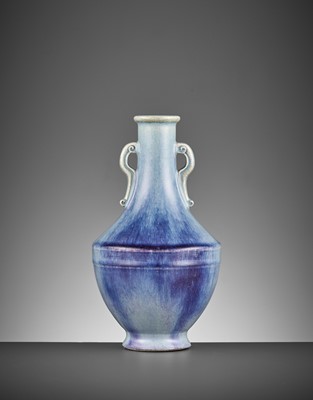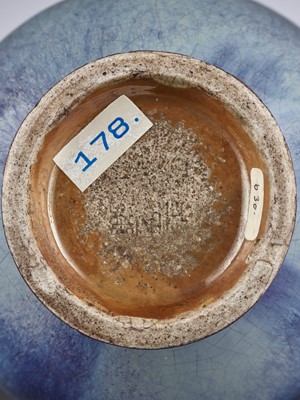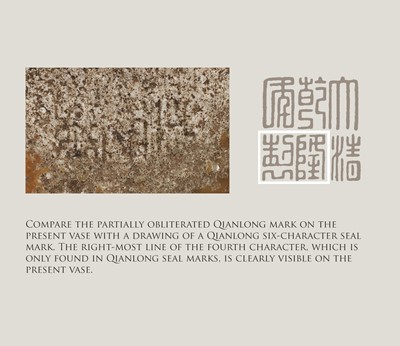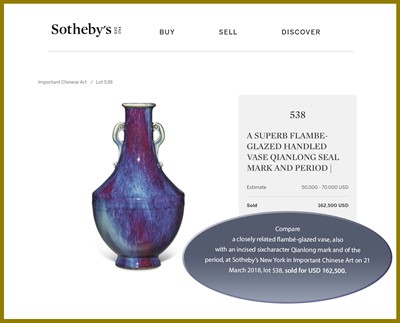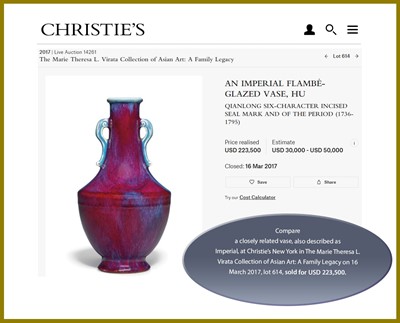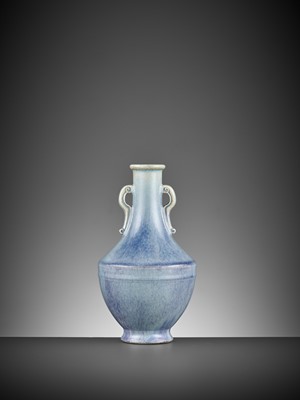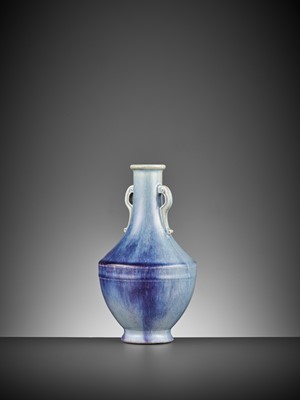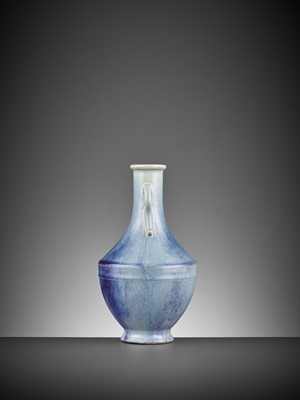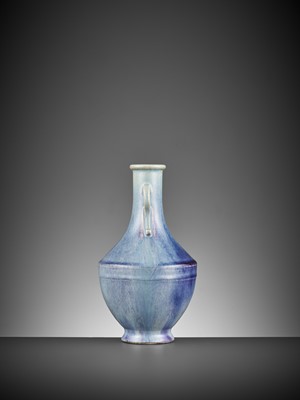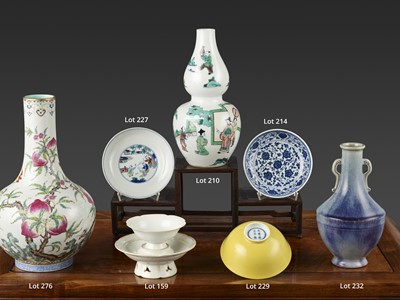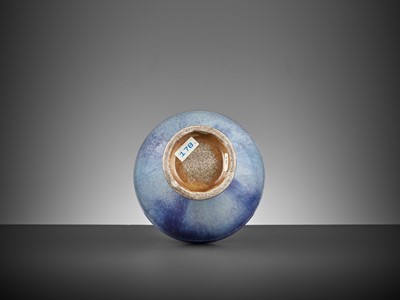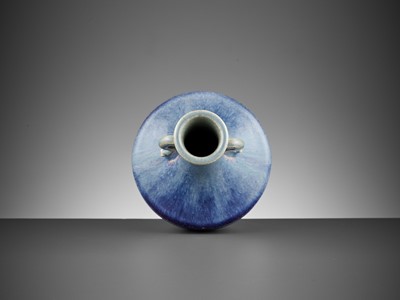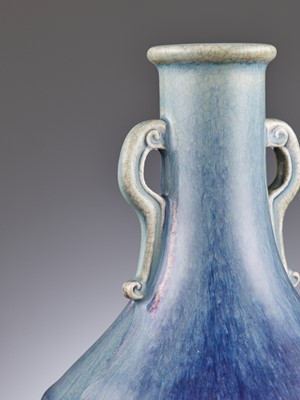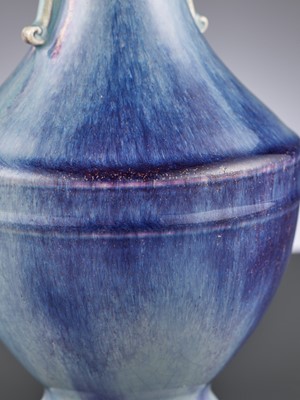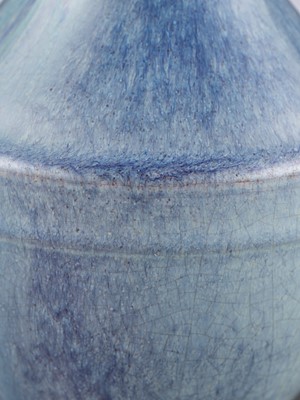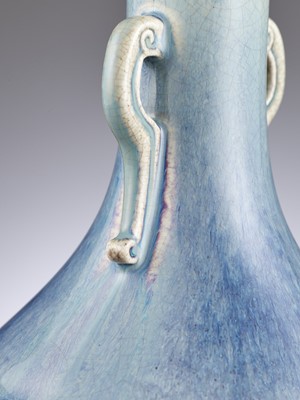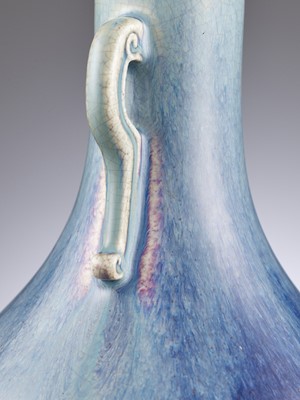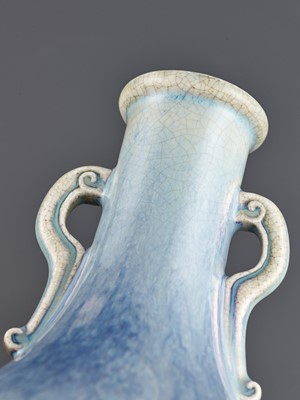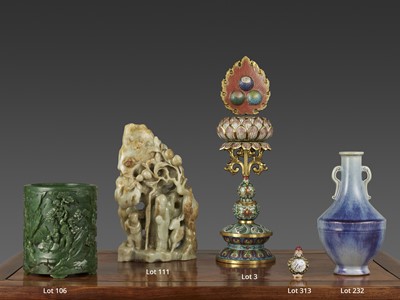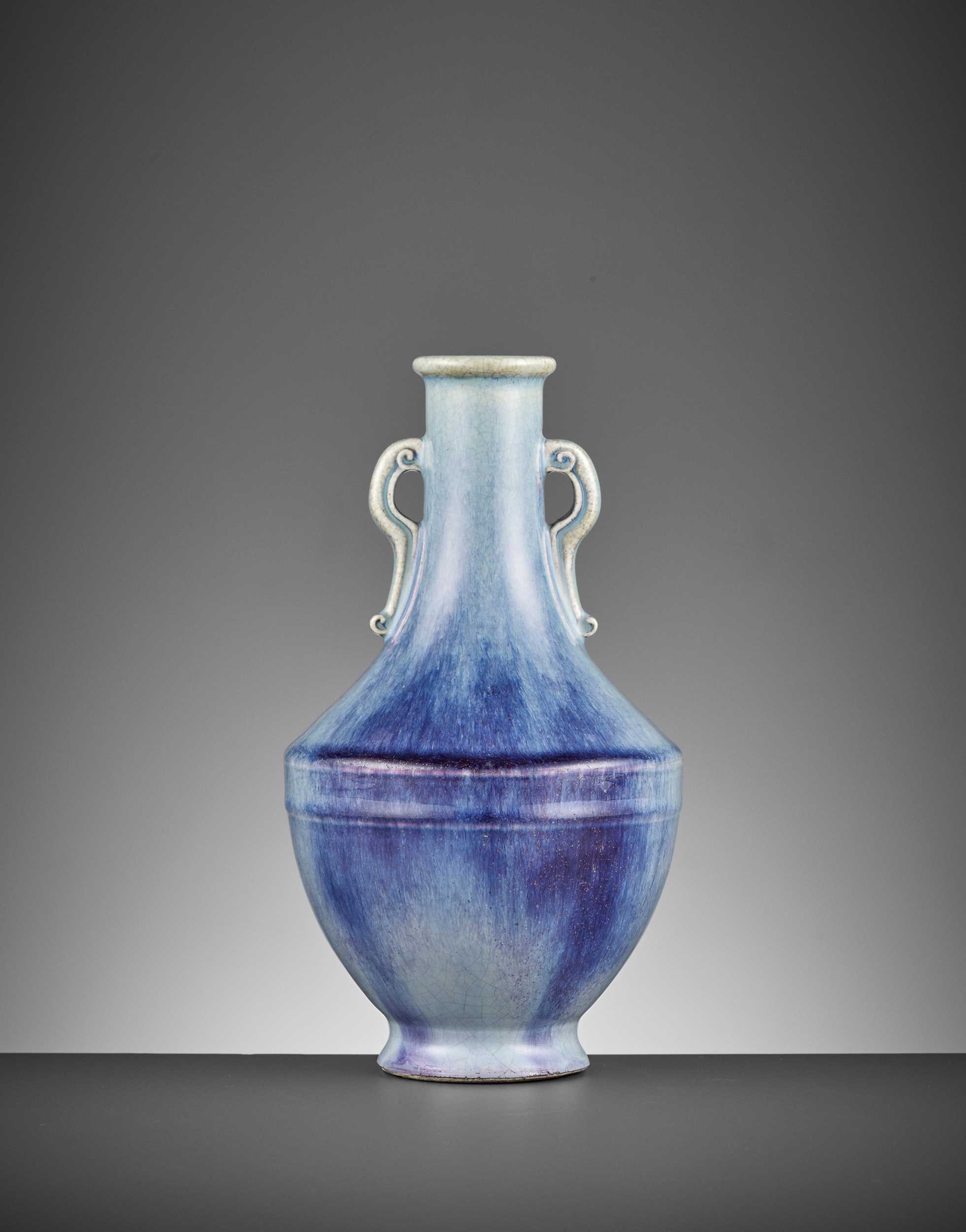15th Oct, 2021 10:00
TWO-DAY AUCTION - Fine Chinese Art / 中國藝術集珍 / Buddhism & Hinduism
232
AN EXTREMELY RARE IMPERIAL FLAMBÉ-GLAZED VASE, QIANLONG MARK AND PERIOD
乾隆款與年代極其罕見窯變釉雙耳瓶
Sold for €56,880
including Buyer's Premium
China, 1736-1795. Covered overall with an unctuous, finely crackled, vibrant, sky-blue glaze highlighted with streaks of lavender-cobalt, draining away from the handles and rim leaving a pale creamy-mushroom color. The interior with pale blue streaks against a creamy-white ground. The base with a café-au-lait glaze and an incised six-character seal mark, da Qing Qianlong nianzhi and of the period.
Provenance: Danish private collection, acquired in China between 1885 and 1945 when members of the family lived there, and thence by descent within the same family.
Condition: Old wear, mostly to the upper bowstring and foot rim, probably due to European mountings present at some point. The mark has been partially obliterated by grinding down the café-au-lait glaze on the base. Some minor firing flaws, irregularities to foot rim, pitting, intentional crackling. The glaze with a great unctuous feel.
Weight: 822.0 g
Dimensions: Height 21.8 cm
The stylized elephant handles on the present lot can be interpreted as xiang, forming the pun taiping youxiang, meaning ‘a sign of peacefulness’. The masterfully potted body rising from a splayed foot to a tall tapered neck and lipped rim, the angular shoulders flanked by a pair of scroll handles and a bowstring band below.
J. Ayers illustrates a larger version without a mark in the Baur Collection - Chinese Ceramics, volume 3, Geneva, 1972, no. A 289, where he notes that “kiln transmutations (yao pien), liable to occur during the firing of the copper-red glazes, were first exploited during the reign of Yongzheng, when attempts to imitate the effects of ancient Jun wares were made, when in some cases - as here - the process was assisted by adding splashes of cobalt.” The present vase epitomizes this process, with its fine glaze appearing like a 12th-century Jun glaze rather than a common flambé glaze.
Expert’s note: Although an attempt to obliterate the incised six-character seal mark da Qing Qianlong nianzhi was made at some point in time, it remains partially legible to the extent that it can be identified with absolute certainty. The fourth character shows distinct features which enable the educated scholar to differentiate it from all other seal marks found on vases of this type, such as Daoguang, Jiaqing or Yongzheng for example. Note that an obscured mark was at least found once before on a vase of this type, namely in the Baur Collection (see Literature comparison).
Literature comparison: Similar flambé-glazed vases, Qianlong seal mark and period, can be found in important museum collections. Compare one illustrated in The Prime Cultural Relics Collected by Shenyang Imperial Palace Museum: The Chinaware Volume, the Second Part, 2007, p. 147; another example in The Capital Museum, Beijing, is illustrated in Xiong Liao, Beauty of Ceramics, Gems of Official Kilns, Taipei, 1993, p. 147; a similar vase in the Exhibition of Chinese and Other Far Eastern Art Assembled by Yamanaka & Co., New York, 1943, no. 915; a fourth flambé-glazed vase is illustrated by Liu Liang-yu, A Survey of Chinese Ceramics: Ch'ing Official and Popular Wares, Taipei, 1991, p. 207; and another example, also with an obscured mark and dated as probably of the Yongzheng period, is illustrated in J. Ayers, Chinese Ceramics in the Baur Collection, vol. 2, Geneva, 1999, pl. 259.
Auction result comparison: Compare a closely related flambé-glazed vase, also with an incised six-character Qianlong mark and of the period, at Sotheby’s New York in Important Chinese Art on 21 March 2018, lot 538, sold for USD 162,500, and another, also described as Imperial, at Christie’s New York in The Marie Theresa L. Virata Collection of Asian Art: A Family Legacy on 16 March 2017, lot 614, sold for USD 223,500.
乾隆款與年代極其罕見窯變釉雙耳瓶
中國, 1736-1795年。小唇口,長頸,雙耳,折肩,腹部下斂,撇足。通體呈藍、紫、月白等多色深淺混雜流動窯變釉,口內與雲形板耳則多作淺月白藍色。器底圈足施醬釉,隱約可見“大清乾隆年製”六字三行篆款,圈足露胎,塗赭色汁。
來源:丹麥私人收藏,1885年至1945年間購於中國,當時家族有成員生活在中國,之後保存在同一家族至今。
品相:舊磨損,主要是圈足邊緣處。可能是此瓶在歐洲有過金屬裝置,由於摩擦,底部的醬釉嚴重磨損,六字款只可模糊辨認。 一些輕微的燒製缺陷,腳緣不規則,凹坑,釉面開片。 釉色具有極好的潤滑感。
重量:822.0 克
尺寸:高 21.8 厘米
專家注釋:“大清乾隆年製”六字款在一定程度上仍能辨認。 第四個“隆”字特徵明顯,所以還是可以將其與其他印章區分開來,例如道光、嘉慶或雍正。 請注意,這種磨損的情況至少在一個瓶上發現過,即在Baur收藏中(參見文獻比較)。
文獻比較:相似窯變釉瓶,乾隆款與年代,可在很多重要博物館中見到。比如《瀋陽故宮博物院原藏文物精粹》,第二部分,2007年,147頁;北京首都博物館 ,熊寥,《官窯名瓷》,臺北,1993, 147頁; 相似瓶見展覽《Chinese and Other Far Eastern Art 》,紐約Yamanaka & Co.藝廊舉辦,1943年,圖915; 第四個窯變釉瓶,見劉良佑教授編寫的《中國歷代陶瓷鑒賞》,臺北,1991年,頁 207; 以及另一個有模糊款印的可能來自雍正朝,見J. Ayers, Chinese Ceramics in the Baur Collection, vol. 2, 日内瓦, 1999年, 圖259。
拍賣結果比較:比較一件窯變釉瓶,乾隆六字款,見紐約蘇富比Important Chinese Art 2018年3月21日lot 538, 售價USD 162,500 ;另一件描述爲“御製“的,見紐約佳士得The Marie Theresa L. Virata Collection of Asian Art: A Family Legacy 2017年3月16日 lot 614, 售價USD 223,500。
China, 1736-1795. Covered overall with an unctuous, finely crackled, vibrant, sky-blue glaze highlighted with streaks of lavender-cobalt, draining away from the handles and rim leaving a pale creamy-mushroom color. The interior with pale blue streaks against a creamy-white ground. The base with a café-au-lait glaze and an incised six-character seal mark, da Qing Qianlong nianzhi and of the period.
Provenance: Danish private collection, acquired in China between 1885 and 1945 when members of the family lived there, and thence by descent within the same family.
Condition: Old wear, mostly to the upper bowstring and foot rim, probably due to European mountings present at some point. The mark has been partially obliterated by grinding down the café-au-lait glaze on the base. Some minor firing flaws, irregularities to foot rim, pitting, intentional crackling. The glaze with a great unctuous feel.
Weight: 822.0 g
Dimensions: Height 21.8 cm
The stylized elephant handles on the present lot can be interpreted as xiang, forming the pun taiping youxiang, meaning ‘a sign of peacefulness’. The masterfully potted body rising from a splayed foot to a tall tapered neck and lipped rim, the angular shoulders flanked by a pair of scroll handles and a bowstring band below.
J. Ayers illustrates a larger version without a mark in the Baur Collection - Chinese Ceramics, volume 3, Geneva, 1972, no. A 289, where he notes that “kiln transmutations (yao pien), liable to occur during the firing of the copper-red glazes, were first exploited during the reign of Yongzheng, when attempts to imitate the effects of ancient Jun wares were made, when in some cases - as here - the process was assisted by adding splashes of cobalt.” The present vase epitomizes this process, with its fine glaze appearing like a 12th-century Jun glaze rather than a common flambé glaze.
Expert’s note: Although an attempt to obliterate the incised six-character seal mark da Qing Qianlong nianzhi was made at some point in time, it remains partially legible to the extent that it can be identified with absolute certainty. The fourth character shows distinct features which enable the educated scholar to differentiate it from all other seal marks found on vases of this type, such as Daoguang, Jiaqing or Yongzheng for example. Note that an obscured mark was at least found once before on a vase of this type, namely in the Baur Collection (see Literature comparison).
Literature comparison: Similar flambé-glazed vases, Qianlong seal mark and period, can be found in important museum collections. Compare one illustrated in The Prime Cultural Relics Collected by Shenyang Imperial Palace Museum: The Chinaware Volume, the Second Part, 2007, p. 147; another example in The Capital Museum, Beijing, is illustrated in Xiong Liao, Beauty of Ceramics, Gems of Official Kilns, Taipei, 1993, p. 147; a similar vase in the Exhibition of Chinese and Other Far Eastern Art Assembled by Yamanaka & Co., New York, 1943, no. 915; a fourth flambé-glazed vase is illustrated by Liu Liang-yu, A Survey of Chinese Ceramics: Ch'ing Official and Popular Wares, Taipei, 1991, p. 207; and another example, also with an obscured mark and dated as probably of the Yongzheng period, is illustrated in J. Ayers, Chinese Ceramics in the Baur Collection, vol. 2, Geneva, 1999, pl. 259.
Auction result comparison: Compare a closely related flambé-glazed vase, also with an incised six-character Qianlong mark and of the period, at Sotheby’s New York in Important Chinese Art on 21 March 2018, lot 538, sold for USD 162,500, and another, also described as Imperial, at Christie’s New York in The Marie Theresa L. Virata Collection of Asian Art: A Family Legacy on 16 March 2017, lot 614, sold for USD 223,500.
乾隆款與年代極其罕見窯變釉雙耳瓶
中國, 1736-1795年。小唇口,長頸,雙耳,折肩,腹部下斂,撇足。通體呈藍、紫、月白等多色深淺混雜流動窯變釉,口內與雲形板耳則多作淺月白藍色。器底圈足施醬釉,隱約可見“大清乾隆年製”六字三行篆款,圈足露胎,塗赭色汁。
來源:丹麥私人收藏,1885年至1945年間購於中國,當時家族有成員生活在中國,之後保存在同一家族至今。
品相:舊磨損,主要是圈足邊緣處。可能是此瓶在歐洲有過金屬裝置,由於摩擦,底部的醬釉嚴重磨損,六字款只可模糊辨認。 一些輕微的燒製缺陷,腳緣不規則,凹坑,釉面開片。 釉色具有極好的潤滑感。
重量:822.0 克
尺寸:高 21.8 厘米
專家注釋:“大清乾隆年製”六字款在一定程度上仍能辨認。 第四個“隆”字特徵明顯,所以還是可以將其與其他印章區分開來,例如道光、嘉慶或雍正。 請注意,這種磨損的情況至少在一個瓶上發現過,即在Baur收藏中(參見文獻比較)。
文獻比較:相似窯變釉瓶,乾隆款與年代,可在很多重要博物館中見到。比如《瀋陽故宮博物院原藏文物精粹》,第二部分,2007年,147頁;北京首都博物館 ,熊寥,《官窯名瓷》,臺北,1993, 147頁; 相似瓶見展覽《Chinese and Other Far Eastern Art 》,紐約Yamanaka & Co.藝廊舉辦,1943年,圖915; 第四個窯變釉瓶,見劉良佑教授編寫的《中國歷代陶瓷鑒賞》,臺北,1991年,頁 207; 以及另一個有模糊款印的可能來自雍正朝,見J. Ayers, Chinese Ceramics in the Baur Collection, vol. 2, 日内瓦, 1999年, 圖259。
拍賣結果比較:比較一件窯變釉瓶,乾隆六字款,見紐約蘇富比Important Chinese Art 2018年3月21日lot 538, 售價USD 162,500 ;另一件描述爲“御製“的,見紐約佳士得The Marie Theresa L. Virata Collection of Asian Art: A Family Legacy 2017年3月16日 lot 614, 售價USD 223,500。
Zacke Live Online Bidding
Our online bidding platform makes it easier than ever to bid in our auctions! When you bid through our website, you can take advantage of our premium buyer's terms without incurring any additional online bidding surcharges.
To bid live online, you'll need to create an online account. Once your account is created and your identity is verified, you can register to bid in an auction up to 12 hours before the auction begins.
Intended Spend and Bid Limits
When you register to bid in an online auction, you will need to share your intended maximum spending budget for the auction. We will then review your intended spend and set a bid limit for you. Once you have pre-registered for a live online auction, you can see your intended spend and bid limit by going to 'Account Settings' and clicking on 'Live Bidding Registrations'.
Your bid limit will be the maximum amount you can bid during the auction. Your bid limit is for the hammer price and is not affected by the buyer’s premium and VAT. For example, if you have a bid limit of €1,000 and place two winning bids for €300 and €200, then you will only be able to bid €500 for the rest of the auction. If you try to place a bid that is higher than €500, you will not be able to do so.
Online Absentee and Telephone Bids
You can now leave absentee and telephone bids on our website!
Absentee Bidding
Once you've created an account and your identity is verified, you can leave your absentee bid directly on the lot page. We will contact you when your bids have been confirmed.
Telephone Bidding
Once you've created an account and your identity is verified, you can leave telephone bids online. We will contact you when your bids have been confirmed.
Classic Absentee and Telephone Bidding Form
You can still submit absentee and telephone bids by email or fax if you prefer. Simply fill out the Absentee Bidding/Telephone bidding form and return it to us by email at office@zacke.at or by fax at +43 (1) 532 04 52 20. You can download the PDF from our Upcoming Auctions page.
How-To Guides
How to Create Your Personal Zacke Account
How to Register to Bid on Zacke Live
How to Leave Absentee Bids Online
How to Leave Telephone Bids Online
中文版本的操作指南
创建新账号
注册Zacke Live在线直播竞拍(免平台费)
缺席投标和电话投标
Third-Party Bidding
We partner with best-in-class third-party partners to make it easy for you to bid online in the channel of your choice. Please note that if you bid with one of our third-party online partners, then there will be a live bidding surcharge on top of your final purchase price. You can find all of our fees here. Here's a full list of our third-party partners:
- 51 Bid Live
- EpaiLive
- ArtFoxLive
- Invaluable
- LiveAuctioneers
- the-saleroom
- lot-tissimo
- Drouot
Please note that we place different auctions on different platforms. For example, in general, we only place Chinese art auctions on 51 Bid Live.
Bidding in Person
You must register to bid in person and will be assigned a paddle at the auction. Please contact us at office@zacke.at or +43 (1) 532 04 52 for the latest local health and safety guidelines.
